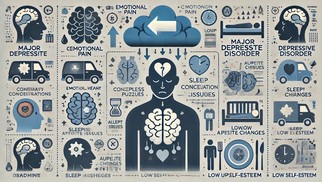Major Depressive Disorder: Understanding Its Impact and Complexity


Mental health is an essential component of overall well-being, yet conditions like major depressive disorder (MDD) often remain misunderstood. This article explores the intricacies of MDD, shedding light on its definition, types, symptoms, and severity compared to other forms of depression.
What Is Major Depressive Disorder?
Major depressive disorder (MDD), commonly referred to as clinical depression, is a mental health condition characterized by persistent and intense feelings of sadness, hopelessness, and a lack of interest or pleasure in activities once enjoyed. It goes beyond the occasional mood swings or temporary sadness most people experience. MDD can affect how a person thinks, feels, and behaves, leading to emotional, psychological, and even physical issues. It is not a sign of personal weakness or a flaw in character but a legitimate medical condition that often requires professional treatment. According to the World Health Organization (WHO), depression is a leading cause of disability worldwide, affecting millions of people of all ages.
Types of Depression
Depression is not a one-size-fits-all condition. Major depressive disorder is the most common type, marked by episodes of severe symptoms lasting at least two weeks. Persistent depressive disorder (PDD), also known as dysthymia, is a chronic form of depression where symptoms are less severe but last for two years or longer. Seasonal affective disorder (SAD) occurs during specific times of the year, typically in fall and winter, due to shorter daylight hours, and is characterized by low energy and sadness. Bipolar disorder, while a separate condition, includes depressive episodes that mimic those of MDD but alternate with periods of mania or hypomania. Postpartum depression (PPD) affects women after childbirth, driven by hormonal changes and emotional adjustment to motherhood. Psychotic depression, a severe form of depression, includes symptoms like delusions or hallucinations, often tied to feelings of guilt or fear. Atypical depression involves symptoms such as increased appetite, excessive sleep, and heightened sensitivity to rejection but is still considered a form of major depression.
What Are the Five Symptoms of Major Depressive Disorder?
The symptoms of MDD can vary, but the Diagnostic and Statistical Manual of Mental Disorders (DSM-5) identifies core indicators. Persistent sadness or low mood is a hallmark feature, where individuals experience constant feelings of emptiness or hopelessness nearly every day for at least two weeks. Another key symptom is a loss of interest or pleasure in activities that once brought joy, such as hobbies or social interactions. Sleep disturbances, whether insomnia or hypersomnia, are also common and can exacerbate other symptoms. Fatigue or low energy is a frequent complaint, with even simple tasks feeling overwhelming. Additionally, feelings of worthlessness or excessive guilt can dominate a person’s thoughts, often leading to irrational self-blame. Other potential symptoms include significant weight changes, difficulty concentrating, and recurrent thoughts of death or suicide. To diagnose MDD, at least five of these symptoms must be present most of the day, nearly every day, for a minimum of two weeks.
Is MDD the Worst Type of Depression?
While MDD is one of the most severe forms of depression, labeling it as the "worst" type is subjective and depends on individual experiences and circumstances. Its hallmark symptoms are intense and debilitating, often interfering with daily life. However, other forms of depression, such as psychotic depression or depression associated with bipolar disorder, can also be extremely severe due to their additional complications, such as hallucinations, delusions, or mood swings. Persistent depressive disorder (PDD) may not involve symptoms as intense as MDD, but its chronic nature—lasting years—can lead to long-term emotional exhaustion and reduced quality of life. For some, the prolonged nature of PDD might feel worse than the episodic intensity of MDD. Certain subtypes of depression, like psychotic or bipolar depression, carry additional risks, including psychosis or heightened impulsivity, increasing the complexity of treatment. Ultimately, the "worst" type of depression is often the one that remains untreated. Regardless of the specific diagnosis, seeking professional help is crucial to recovery.
Understanding the Causes and Risk Factors
MDD is a complex condition with no single cause. It arises from a combination of genetic, biological, environmental, and psychological factors. A family history of depression or other mental health disorders can increase susceptibility. Imbalances in neurotransmitters, such as serotonin and dopamine, play a significant role in brain chemistry. Traumatic experiences, such as childhood abuse or significant life stressors, can trigger MDD. Chronic medical conditions, including diabetes, heart disease, or cancer, are often linked to depression. Substance abuse, whether involving alcohol or drugs, can exacerbate or even trigger depressive episodes. Understanding these factors helps in developing tailored treatment plans.
Treatment with Medication: The Role of Celexa
Medication plays a vital role in the treatment of major depressive disorder, particularly for individuals with moderate to severe symptoms. Celexa, the brand name for citalopram, is a commonly prescribed antidepressant in the selective serotonin reuptake inhibitor (SSRI) class. SSRIs work by increasing the levels of serotonin in the brain, a neurotransmitter associated with mood regulation. Celexa is particularly effective for individuals experiencing persistent sadness, loss of interest, and other core symptoms of MDD. It has been shown to improve mood, energy levels, and overall quality of life by stabilizing the brain’s chemical balance. Celexa is typically prescribed at a starting dose, which may be adjusted based on the patient's response and tolerance. Like any medication, it may cause side effects, such as nausea, dry mouth, or fatigue, but these often subside as the body adjusts. For some, more serious side effects like changes in heart rhythm can occur, so regular monitoring by a healthcare provider is essential. Importantly, Celexa and other SSRIs are not immediate fixes; they may take several weeks to achieve full therapeutic effects. Patients are advised to continue taking the medication as prescribed and not to discontinue use abruptly, as this could lead to withdrawal symptoms or a relapse. Combined with psychotherapy and lifestyle modifications, Celexa can be a cornerstone of a comprehensive treatment plan, offering hope and relief to those battling MDD.
Treatment and Hope for Recovery
The good news is that MDD is treatable, and early intervention can significantly improve outcomes. Psychotherapy, such as cognitive-behavioral therapy (CBT) or interpersonal therapy (IPT), helps individuals identify and manage negative thought patterns while developing coping strategies. Medication, including antidepressants like selective serotonin reuptake inhibitors (SSRIs) or serotonin-norepinephrine reuptake inhibitors (SNRIs), can help balance brain chemistry. Lifestyle changes, such as regular exercise, a balanced diet, adequate sleep, and mindfulness practices, can support overall mental health and enhance treatment efficacy. Emerging treatments, like transcranial magnetic stimulation (TMS) and ketamine therapy, offer hope for individuals with treatment-resistant depression. Support networks, including family, friends, and support groups, play a crucial role in reducing feelings of isolation and providing emotional backing.
Conclusion
Major depressive disorder is a serious and complex mental health condition that affects millions worldwide. While it is one of the most challenging forms of depression, it is not insurmountable. By understanding the different types of depression, recognizing the symptoms, and seeking appropriate treatment, individuals with MDD can lead fulfilling lives. If you or someone you know is struggling with depression, reaching out to a healthcare professional is the first step toward recovery. With the right support and treatment, hope and healing are within reach.
Article post: Editorial Team of RXShop.md
(Updated at Jan 2 / 2025)